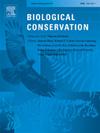Local ecological predictions as input to adaptive management of natural plant communities
IF 4.9
1区 环境科学与生态学
Q1 BIODIVERSITY CONSERVATION
引用次数: 0
Abstract
Using ecological monitoring data and the hypothesized causal relationships in a structural equation model, it is possible to generate short-term ecological predictions of vegetation cover as a function of the local levels of environmental drivers (nitrogen deposition, soil pH, soil texture, precipitation and grazing). Some of these environmental drivers may be manipulated in an adaptive management plan, and local ecological predictions will provide important input for setting-up adaptive management plans. It is critical to quantify the different sources of uncertainty of the predictions. In a case study of four management scenarios at a specific calcareous grassland site, the effect of reduced grazing and nitrogen deposition on the cover of sensitive species after five years was predicted. The management scenarios were predicted to have large and different effects on the predicted relative cover of sensitive species after five years. It was predicted that the current management practice would lead to a significant decrease in the relative cover of sensitive species after five years, whereas reduced grazing and reduced nitrogen deposition was predicted to lead to increasing cover of the sensitive species. Importantly, the local climate and soil characteristics were accounted for in the predictions.
求助全文
约1分钟内获得全文
求助全文
来源期刊

Biological Conservation
环境科学-环境科学
CiteScore
10.20
自引率
3.40%
发文量
295
审稿时长
61 days
期刊介绍:
Biological Conservation is an international leading journal in the discipline of conservation biology. The journal publishes articles spanning a diverse range of fields that contribute to the biological, sociological, and economic dimensions of conservation and natural resource management. The primary aim of Biological Conservation is the publication of high-quality papers that advance the science and practice of conservation, or which demonstrate the application of conservation principles for natural resource management and policy. Therefore it will be of interest to a broad international readership.
 求助内容:
求助内容: 应助结果提醒方式:
应助结果提醒方式:


